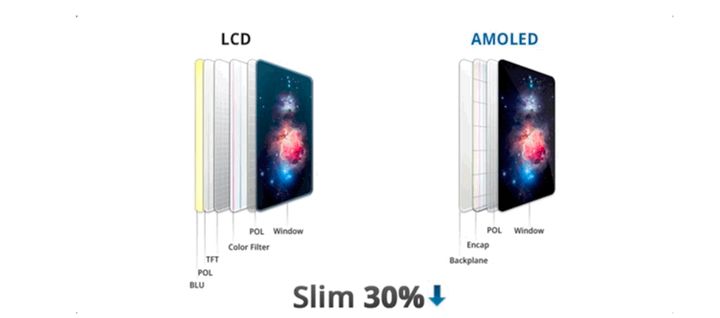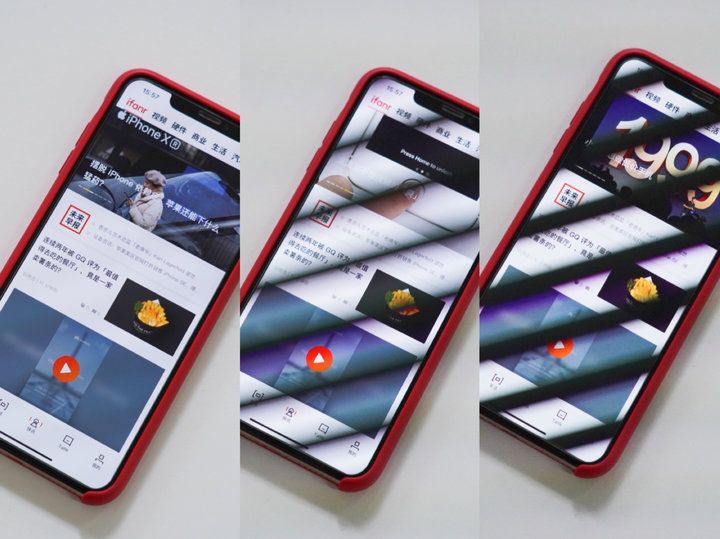OLED screen and LCD screen are two different screens currently used for iPhone. The main difference between the two comes from the difference in luminous methods.
The LCD screen relies on backlit board to emit light. It needs to install red, green and blue filters in front of white backlight, separate them with liquid crystal layers, and then add polarizer and glass substrate. The whole is thicker, about 0.6-0.8mm;
The OLED screen uses organic compounds. When the current passes through, the sub-pixels can emit red, green, and blue light by themselves. No additional backlit board and filters need to be added, and no liquid crystal layer is required, only one polarization layer is needed, and the thickness can reach 0.3mm.

Color Display
The OLED screen can control the color at the pixel level, so the color accuracy is almost perfect and can hardly be distinguished by the naked eye. Since 100% black can be expressed by extinguishing pixel points, in theory, OLED screen has almost infinite contrast; The latest iPhone 11 Pro series has a screen brightness of 800 nits, ensuring that the screen content can be clearly displayed even in the noon sun.
Since the color brightness of LCD screen can only be adjusted by backlit board, and the liquid crystal deflection cannot achieve 100% shading, there are some errors in the color expression of each pixel, so the accuracy, the contrast is slightly lower.
Dynamic Display
OLED has a faster switching speed than LCD (the time required for each pixel to completely change the color), and the best LCD display can completely switch the color within a few milliseconds (QIANFENZHIYI seconds), however, the best OLED display only needs a few microseconds (one millionth of a second) to completely switch colors. When playing games or playing dynamic video content, the probability of content blurring or trailing is smaller.
Energy saving
When pixels are not expressed (such as black), OLED can directly cut off the power supply of corresponding pixels, effectively saving electricity. The LCD screen can only save energy by lowering the overall brightness of the screen, and the energy saving efficiency is relatively low.
Stroboscope
The strobe problem mainly lies in the difference between the two screen dimming methods.
If you need to reduce the brightness of the LCD screen, you only need to directly adjust the brightness of backlit board, so you can easily realize global DC dimming (DC dimming refers to adjusting the screen voltage or current, that is, to change the power to control the display brightness).
Since the OLED screen does not have backlit board, when changing the display brightness, if the power is directly adjusted, problems such as uneven color and inaccurate color rendering will occur under low brightness. In this case, many manufacturers begin to apply PWM dimming on OLED screens.
PWM dimming can achieve continuous display effect by controlling the screen to flicker alternately at a certain frequency without changing the power. Simply put, PWM dimming is the continuous alternation of brightness, extinction, brightness and extinction. The slower the flicker frequency, the lower the actual brightness. This also causes the problem of stroboscope in PWM dimming.
A study by the International Institute of Electrical and Electronic Engineers (IEEE) shows that the stroboscope with low impact on human health should be above 1250Hz; Those that basically do not affect human health should be above 3000Hz at least.
At present, the stroboscope of LCD screen is above 1000Hz, while the stroboscope rate of OLED screen mobile phone adopting PWM dimming technology is about 200Hz ~ 250Hz. As the brightness of the screen decreases, the stroboscope rate will also decrease. Therefore, in the case of low brightness display, OLED is more likely to cause eye fatigue than LCD.

Screen burning
Because OLED requires each pixel to emit light by itself, and different color pixels have different luminous life due to different materials. If a region displays a high light source for a long time, the pixels in the region will age faster than the surrounding pixels, just as the electric lamp will break down after being used for a long time, these pixels will also age faster, resulting in branding in this area.
The problem of screen burning is an unavoidable problem for OLED screens. Apple has joined the anti-screen burning mechanism since iOS11. Media tests show that, iPhone X the screen will not burn until 510 hours after a picture is continuously displayed at the highest brightness. The “Dark Mode” added to iOS 13 is not only to extend the battery life of the mobile phone, but also to avoid screen burning.
For LCD screen, the risk of “burning screen” can be ignored.
